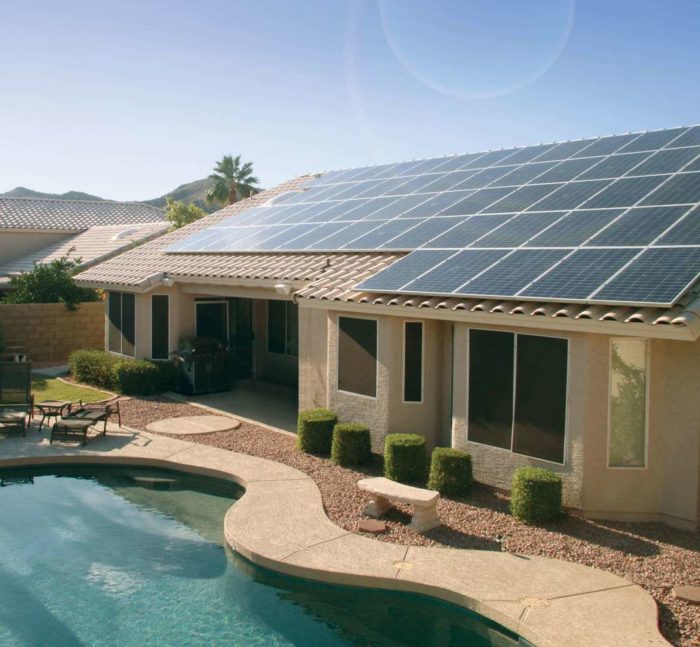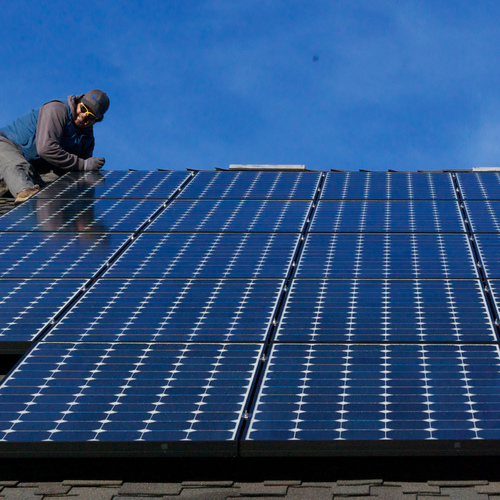
Image Credit: SolarCity
Rocky Mountain Power is seeking permission from regulators to tack on an extra $4.25 a month to the power bills of Utah customers with photovoltaic (PV) systems.
According to a summary posted at Utilitydive.com, the utility has about 2,000 customers in the state with rooftop solar arrays who typically use 100 kilowatt-hours less electricity than non-solar residential customers.
Rocky Mountain Power says the flat fee, which is part of a current rate case before the Utah Public Service Commission, would help pay the fixed cost of maintaining the electricity grid, which net-metered solar customers still need.
Making a point that’s become familiar in similar rate cases around the country, Rocky Mountain spokesman David Eskelsen told ThinkProgress.org that as the number of solar customers grows, non-solar customers are picking up a greater financial share of grid maintenance.
“It’s important to emphasize that this is all about rate design,” he said. “It doesn’t result in more revenue for the company, it doesn’t result in more profit. It’s about designing a rate structure for the future when more customers use their power in a very different way.”
Under net-metering rules posted at Rocky Mountain Power’s website, solar customers are paid the full retail rate for excess power they generate.
Eskelsen told The Salt Lake Tribune, “The main benefit of net metering is to lower the bill of the user. It doesn’t contribute to system peaks. It doesn’t forestall generation from power plants or supply energy to neighbors in any meaningful way. That’s the reason for the proposed charge.”
Critics claim that the benefits of PV are overlooked
Opponents of the proposed surcharge say Rocky Mountain is overlooking the benefits that rooftop PV systems and other forms of distributed generation provide, such as reducing the use of fossil fuels and easing the strain on utilities at times of high demand for electricity.
Groups including Utah Citizens Advocating Renewable Energy, Utah Clean Energy, Healthy Environment Alliance of Utah and the Sierra Club, are fighting the proposal. They argue Rocky Mountain is unfairly singling out solar customers, and that the fee will dampen the state’s growing solar market.
“Instead of working proactively to modify their current business model to accommodate a more efficient, more resilient, and more state-of-the-art energy system, RMP is not only trying to keep us stagnant, but to take us steps backwards,” Utah Clean Energy says at its website.
Adds the Healthy Environment Alliance: “Rocky Mountain Power has offered no proof that rooftop solar owners cost the system money overall. The company willfully ignores for example, the many benefits that solar brings to the system.”
Same debate rages elsewhere
Surcharges for solar customers have been proposed or implemented elsewhere. In Maine, the state’s largest utility wants to add a “standby” rate of about $13 a month to the bills of residential customers with grid-tied renewables. It would affect about 1,000 institutional, residential and commercial customers.
In January, the Arizona Public Service Company began imposing a surcharge of 70 cents per kilowatt (an average of $5 a month) on customers who generated some of their own power. The fee didn’t affect customers who already had installed renewables.
The backdrop to these and other regulatory tussles is the struggle by electric utilities to protect their bottom lines as more customers add solar or wind. Key issues are net-metering rules and how utilities calculate the value of rooftop solar and small-scale wind.
In Colorado and California, for instance, utility regulators are considering ways of replacing the current net-metering reimbursement rates with something else. In Massachusetts, utilities have agreed on a plan to retain net-metering incentives but would begin requiring owners of renewable energy systems to chip in for distribution expenses. The plan must still be approved by the state legislature.
The stakes are especially high in Hawaii, which has the costliest electricity in the country. Rooftop solar is growing quickly, and regulators have been sharply critical of efforts by the Hawaii Electric Company to embrace renewables. The state has has a renewable energy portfolio goal of 40% by 2030.
Lower costs and a variety of incentives are helping to grow the solar market. But net-metered customers still make up a tiny fraction of total utility customers, reports the Solar Energy Industries Association. In California, the state with the most installations in the country, less than 1% of all customers have net-metered connections. The only state where solar customers make up more than 1% of the customer base is Hawaii, the SEIA says, with just over 2% of the total.
Weekly Newsletter
Get building science and energy efficiency advice, plus special offers, in your inbox.















2 Comments
Heres to the Harvard university organic flow batteries
I cant wait for the technology that Harvard university have proven in the form of an organic flow battery
Takes up the space of a small oil tank in the basement but it stores your excess solar power during the day and should be cheap too
Then bye bye Orange and Rockland (part of Con Ed, or Conned as I call them) the end of the only monopoly in this country is coming
Im sick of these scum bags taxing (since thats what it is) people who threaten their bottom line
Hmm
"with rooftop solar arrays who typically use 100 kilowatt-hours less electricity than non-solar residential customers."
Let's see 100KWh * $0.06/kWh = $6 -- that seems reasonable. But when you consider consumers are replacing old TV's with units LED TV's that use 300kWh+ less a year, replace refrigerators with units that save 200kWh/yr, unplug Xbox, replace dishwashers with units that save 200kWh/yr, etc, pretty soon you'd have to ask why you aren't charging customers that use more energy efficient appliances also.
Or perhaps the utility will start going after the buildings with tight envelopes , passive houses, because they also use less energy each month.
Then there is a quote - "The main benefit of net metering is to lower the bill of the user. It doesn't contribute to system peaks. It doesn't forestall generation from power plants or supply energy to neighbors in any meaningful way. That's the reason for the proposed charge."
WECC (Western US Electric Coordinating council - of which the utility is probably a member) notes that solarPV production in the west aligns with peak electrical use for about 60% of the time. And certainly solarPV in the Salt Lake area would help eliminate the fossil fuel burning that can contribute to some smog problems...
Utilities fighting net-metering AND energy efficiency as in Ohio, is entirely about money. It is about how to maintain revenue streams.
It seems like it may only be a matter of time before utilities come out and measure the square feet of the house, run it through their modeling and set the monthly base rate based on how much you should be using each month...
Log in or create an account to post a comment.
Sign up Log in